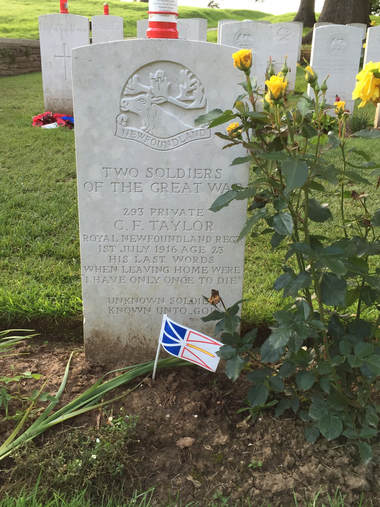All program participants receive a Canadian soldier's military service file and prepare a biographical sketch to read at his grave. The files are provided by Library and Archives Canada through a program called Lest We Forget, which provides learners with these primary sources as entry points to understanding the conflicts in which these soldiers fought. Some participants' biographies are written, while some others choose to compose songs or prepare pieces of theatre.
Tips for Getting Started

Participants are given a list of questions to help them get started on researching their soldier:
1. What do the documents reveal to you about your soldier?
2. Is there another possible interpretation of your documents?
3. How could you verify your interpretation? Where might you
need to search for relevant resources?
4. How is your soldier’s information similar or different to
information being researched by other teachers?
5. What are the short and long term consequences for
communities that suffer from the loss of local men to war?
6. What events that emerge out of the documents do you
consider to be historically significant?
7. Can you determine what other people may be affected by
the events that emerge out of the documents? (mother,
wife, father, sister, brother, community, industry, etc…)
8. How does your research connect to issues at the time?
9. What issues that you identified are still relevant today?
Explain your thinking.
10. How is each issue similar or different from today and when
written?
11. Based on your research what information do you consider
to be the most significant? How did you determine this?
1. What do the documents reveal to you about your soldier?
2. Is there another possible interpretation of your documents?
3. How could you verify your interpretation? Where might you
need to search for relevant resources?
4. How is your soldier’s information similar or different to
information being researched by other teachers?
5. What are the short and long term consequences for
communities that suffer from the loss of local men to war?
6. What events that emerge out of the documents do you
consider to be historically significant?
7. Can you determine what other people may be affected by
the events that emerge out of the documents? (mother,
wife, father, sister, brother, community, industry, etc…)
8. How does your research connect to issues at the time?
9. What issues that you identified are still relevant today?
Explain your thinking.
10. How is each issue similar or different from today and when
written?
11. Based on your research what information do you consider
to be the most significant? How did you determine this?
Participants are also asked to research the geography of the region surrounding their soldier's burial site and to consider the following:
1. The physical terrain features that shape the region
2. The population density of the region
3. The region's economic activities
4. The region's cultural attributes
5. The region's climate and environment
6. How the burial site relates to the region
1. The physical terrain features that shape the region
2. The population density of the region
3. The region's economic activities
4. The region's cultural attributes
5. The region's climate and environment
6. How the burial site relates to the region
Exemplars
Please note that this video demonstrates only two of the many ways to prepare and present a soldier biography.
|
Karen and Riley, two of the 2017 War and the Canadian Experience tour participants, both researched Corporal Fredrick Ralph Brooks; therefore, they combined their biographical sketches into one presentation.
|
Since Lynzee teaches at J.B. Croak V.C. Meremorial School, she asked to research the school's namesake: Victoria Cross winner Private John Bernard Croak.
|
|
|
|
Gallery
While we presented our soldier biographies, Cindy, Blake, and Lee completed grave rubbings of our soldiers' headstones. The slideshow below features images of the grave rubbings, which were displayed in the classroom at the Moulin Morin during our stay in Normandy.
